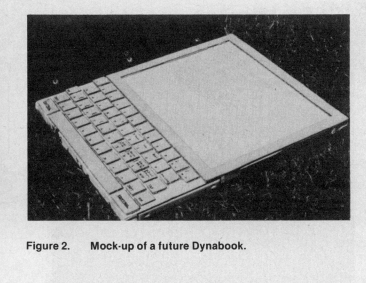Alan Kay, 1972

- related to Smalltalk, Xerox Alto
- meta-medium - can simulate all existing media, and create new ones that can't exist without the computer
- built for children, to shape their thinking (debugging)
- interesting that turning point in this project was meeting Seymour Papert and Cynthia Solomon
the actual "Dynabook" idea came a few months later in the Fall of 1968 after I had visited Seymour Papert and Cynthia Solomon's first LOGO classrooms. This changed my view of computers and personal computers from just "vehicles" and "tools" to "meta-media" and "for children in important ways also".
In other words, what got added to the simple idea was "cosmic purpose", "service", "curricula", etc. The big hit from Papert and Solomon was that careful use and design of interactive computing could make a qualitative difference in the higher-level shaping of children's thinking — not just learning important things earlier, but in taking on a much more powerful "epistemological stance" towards the world they were growing up in — to the point where they should be able to think much better than most adults do today (not a big feat, but desperately needed), and be stronger shapers of the future (really desperately needed).
what is the carrying capacity for ideas of the computer?... the computer is a meta-medium - it can simulate any existing media also be the basis of media that can't exist without the computer. I was particularly drawn to the idea of better childhood education with the new possibilities to represent powerful ideas that the computer brought would be a strong way to help children "grow up thinking much better than most adults do today".
(...)
Tools solve very specific problems. Cut-and-paste is a tool. The lasso is a tool. Even something like changing the font size is a tool. A medium, by contrast, is a platform for some broad class of creative expression. You can imagine carrying out a meaningful creative project within such a medium. Photoshop is a medium. Microsoft Word is a medium. The web browser is a medium.
— https://mnielsen.github.io/notes/kay/dynabook.html#slide-38
Today we have the possibilities of: a DYNAmic Better Organization Of Knowledge, and we need to make this, and use it to the fullest.
I've been also continuing research at Ink&Switch around the topic of "programming by drawing" for a tablet form-factor (trying to bring some of the Dynabook ideas to life). Latest spin-off work includes in-house Lisp with a projectional editor. This work is not public yet, but if you're interested in these topics, I'm happy to give a demo on a call.
One way to think about a Dynabook is that it is mainly centered about all aspects of user interface design, especially for children, and not just about how to access, learn and use a computer but how to access, learn and use ideas.
- Dynabook was supposed to be a tool for children to learn how to "use ideas" and create new ones - so an ideation tool in a sense